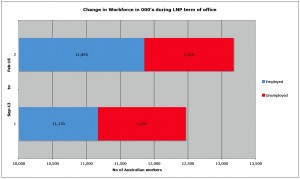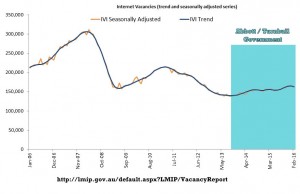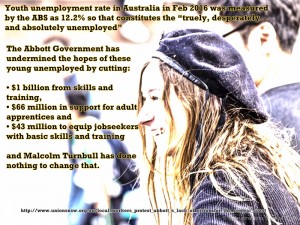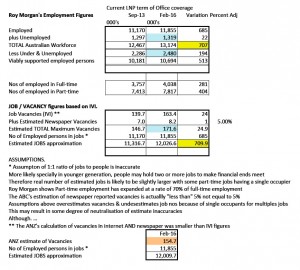Jobs and Growth – Part Two
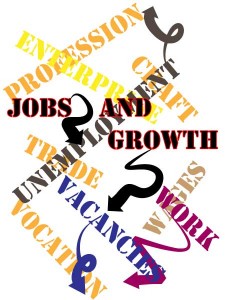
As already outlined in part one of examining the mantra of the Coalition’s claim to be creating “jobs and growth”, jobs in the economy are in inadequate supply. Indeed when you consider the vast numbers of under and unemployed on record, as well as the numbers of foreigners eligible to look for and consume jobs in the market, jobs are relatively non-existent. But if there is potential for economic growth in the Australian market, albeit little hope for millions of Australians to find suitable work in the short term, then perhaps there is hope for the long term holds. Perhaps, given enough time, the Coalition – who want you to believe they pride themselves on being “THE economic managers” – can pull a “rabbit out of the hat” and grow the economy to generate more job vacancies for the unemployed to fill than the rate of expansion of the workforce. For now, they are struggling to do this.
Growth?
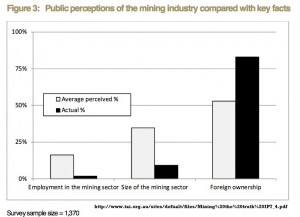
So, with the Coalition supposedly focusing on “Jobs and Growth”, exactly what infrastructure is the government committing to, to creating growth in our economy? There is a big focus to one of the large contributors to the LNP, of the Mining Industry. Mining reaps the benefit by our largess in revoking emissions trading and mining taxes and billions in subsidisation of fuel, exploration costs, grants and cheap loans. All of which results in profit margins well in excess than these subsidies, most of which goes overseas, as mining is 83% foreign owned. Despite the big sell of the benefits of mining by the government – which the public largely buys – the reality is quite different. Mining investments are a diminishing industry with declining jobs – now down to 2% and a negligible contribution to GDP. In fact nothing at all in the Dec 2014 quarter. As jobs were disappeared from mining, the expected pickup in Construction did not occur and had in fact begun failing us as well – as it fell 3.6% in the last December Quarter with every expectation of it continuing to weaken. Any new mines – despite exaggerated claims to the contrary by the coalition about the Adani Mine – will take up tiny numbers of our unemployed as Rod Campbell demonstrates in “The Australian”. So no growth in these industries, unless you are talking about increasing workplace deaths in which case the reintroduction of the ABCC in construction is useful. The previous regime of the ABCC saw dramatic rises in construction industry deaths under the Howard Government because of a lack of the union’s ability to enforce safety standards. There was a rapid drop off of deaths once it was abolished. This would be a small boon for employment as more workers die quickly then vacancies in the construction industry will arise more often. The uptake of the unemployed into construction will help reduce unemployment’s numbers. So while mining and construction are not growing, and is shedding employee numbers, the rollover of employees through the implementation of ABCC style legislation may be of benefit to the unemployed – should they survive the experience. It certainly has no powers to combat corruption so there must be other reasons for its existence. The government’s desire to expand this style of legislation into other industries such as the Registered Organisations Bill, would potentially expand businesses capacity to roll through the unemployed as they “dropped” off, while not necessarily contributing to the real growth of the businesses in question or addressing any union corruption issues.
Exploring other industries, we might note the government have undercut our manufacturing sector as car manufacturers will bleed 200,000 jobs and as much as $29 billion in lost economic output. The steelmaking company Arrium, which employs one in ten people in the South Australian town of Whyalla, just went into administration in April this year (2016). SPC fruit canning industry only needed a tiny fraction of the money we hand out to mining to protect the industry and jobs. The Manufacturing Worker’s Union had no success at convincing Abbott to adopt a less hard-line approach to our canneries.
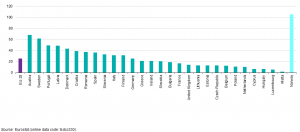
RET and renewable energy changes from both Abbott and Turnbull have devastated a growing industry that had a vibrant future. This is evidenced by the progress established in multiple European countries who despite many having less sunshine & wind access than Australia, are contributing significantly to their energy needs and in Norway’s example exceeding their energy requirements from renewables.
The change from public transport initiatives to road building means people are more dependent on vehicles at a greater cost to the consumer and the environment. (Perhaps Joe Hockey will be right after all, and poor people won’t be able to afford cars) Other OECD countries have developed public transport that keeps travel costs low by the clever development of properties around the transport hubs (school, hospitals, shopping centres, etc.transport). The lack of investment in public housing in city CBDs means that disenfranchised people are more remote than ever from employment opportunities, health and education services. So no growth in transport or city building infrastructure except for the most etransportation options for the public.
Health follows wealth and employment follows education, so the inadequate or lack of infrastructure development in these areas will equate to the failure to invest in human capital. This represents appalling short-sightedness at a time when China’s tertiary sector, Singapore, South Korea and Japan (and in time, Indonesia) are making dramatic consolidations around trade and education. They are gearing their workforce up to be able to participate effectively in 21st-century technology economies while Australia’s professional full-time occupations are declining according to the Graduate Careers Survey from the CGA. As degree qualifications become more expensive, the long-term outlook is not optimistic. Integral to this is that Australia is creating an NBN system that has us ranked down from 30th in the world to 60th in internet speeds. The educational advantages of online learning specifically for a country like Australia where distance education is a pertinent need is undercut by our pathetic internet offerings. Cutting the Gonski funding for our children reduces the future level of education for our nation. It’s simply short-sighted. From education to health, the prognosis is also heart stopping. Given the reduction in funding by removing previous indexing arrangements for hospital funding to “save” $80 Billion, the Government’s commitment to health in the midst of a population with an increasing proportion of aged care needs is counter-productive. If you want your population’s retirement age to be delayed as Howard, Abbott and Hockey suggested, then you need to cater for rising health costs, not diminish them. So no growth in health and education.

Under the coalition, Australia has dismantled active market labour programs creating the ineffective “work for the dole” scheme, where people are forced to paint community halls and rake garden paths. This semi skilled meaningless busy work is not dissimilar to the enforced programs that you see in North Korea. It is, after all, a means by which people are forcibly employed at below minimum wage rates with penalties extracted for failures to comply. Perhaps a North Korean labour camp is not that big of a jump, conceptually? Neither scheme in Australia or North Korea results in fulfilling full-time work.
Tourism and Agriculture although are key growth areas for Australia. Given there are 267,000 tourism businesses in Australia 95% of which are micro businesses which outside of the casino industry and hotel and hospitality association are not broad enough to afford to donate to the Liberal Party to attract favourable considerations. Given Mining can do so; it is no surprise that it is given priority over tourism and agriculture. As the Australian Institute has pointed out: “The expansion of mining causes a contraction in non-mining industries, particularly manufacturing, tourism, agriculture and education. This results in business closures and job losses”. Recent government decisions in regards tailings dumping on the Great Barrier Reef and the Shenhua mine’s resumption of farming land in NSW bear these assumptions credit. Support for these industries by the government is certainly not a priority.
Given the history of ongoing falls in consumer and business confidence, apart from a temporary boost at the change of Coalition leadership, there has been too little evidence of worthwhile growth in Australia. In fact, if it were not for the way we account for defence spending, by only accounting for all previous payments as one lump sum presumed to be paid in total on the final instalment for an “item”, Australia’s economic outlook would be dire. Change the accounting convention to recognise the defence payments when they were made, and Australia would be officially in recession.
Unemployment is an pernicious problem not being dealt with by a government that is busy dismissing public servants and growth industries and their support mechanisms (Renewable Energy projects) and undermining manufacturing in this country and reducing funding for numerous Not-for-Profits (i.e ABC, SBS, CSIRO, the Climate Commission and dozens of expert advisory bodies). All of these resulting in massive retrenchments, increasing the stress levels of employees in these and related industries leading to the aforementioned reduction in economic growth that this country is experiencing.
So, given the coalition’s reluctance to tax the wealthy or large businesses which contribute significantly to the Liberal Party but next to nothing in taxes to the Australian people’s health, wealth, infrastructure and even employment, where will we find the revenue to support Australians? The continued reluctance to pull back the massive welfare subsidisation of such companies which contribute so little to our GDP – such as mining & construction, is deeply inegalitarian when one considers how little welfare we supply to Australians who have real financial needs. The service sector contributes 68.7% of our GDP, but where the government’s policies do either so little for or are inhibiting the non-finance segments of it, from what do we then build national revenue? An economy where it is no longer possible to raise sufficient revenue from income tax because people don’t have jobs, explains the coalitions desperate bids to reduce services to the community. “JOBS AND GROWTH” have been the mantra of the Government for the last three years, worryingly resulting in such a poor performance that we risk further economic collapse. And, in the next financial year, we may not have fully paid off the next defence purchase in time to hide the reality, that Australia, will be in a recession.
